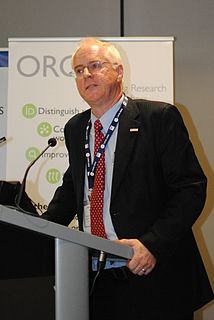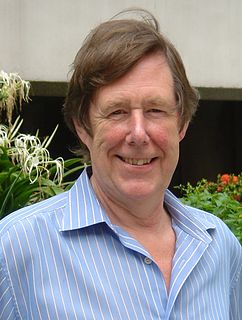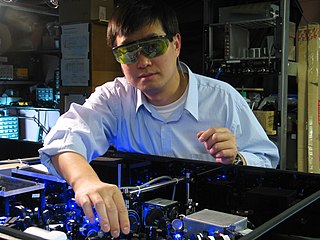
John Lewis "Jan" Hall is an American physicist, and Nobel laureate in physics. He shared the 2005 Nobel Prize in Physics with Theodor W. Hänsch and Roy Glauber for his work in precision spectroscopy.
Sir David Neil Payne CBE FRS FREng is a British professor of photonics who is director of the Optoelectronics Research Centre at the University of Southampton. He has made several contributions in areas of optical fibre communications over the last fifty years and his work has affected telecommunications and laser technology. Payne’s work spans diverse areas of photonics, from telecommunications and optical sensors to nanophotonics and optical materials, including the introduction of the first optical fibre drawing tower in a university.

Keith Alexander Nugent FAA is an Australian physicist. He is the Deputy Vice-Chancellor of the Australian National University (ANU) in Canberra.
Sir Eric Albert Ash was a British electrical engineer, past Rector of Imperial College and President of IEE, UK. He was elected an international member of the National Academy of Engineering in 2001 for innovations in optics and acoustics and for leadership in education.

Sir Peter Leonard Knight is a British physicist, professor of quantum optics and senior research investigator at Imperial College London, and principal of the Kavli Royal Society International Centre. He is a leading academic in the field of quantum optics and is the recipient of several major awards including the Royal Medal from the Royal Society and the Thomas Young Medal and Prize from the Institute of Physics. He is a former president of the Institute of Physics and the Optical Society of America, the first non North American-based person to take the position.

Min Gu is a Chinese-Australian physicist who currently serves as the Executive Chancellor and Professor at the University of Shanghai for Science and Technology. Previously he was Distinguished Professor and Associate Deputy Vice-Chancellor for Research Innovation & Entrepreneurship at RMIT University.
Edward Allen Hinds FInstP FAPS FRS is a British physicist noted for his work with cold matter.

Benjamin John Eggleton FAA, FTSE, FOSA, FIEEE is the Director of The University of Sydney Nano Institute. He also currently serves as Co-Director of the NSW Smart Sensing Network (NSSN).

Colin Sheppard, usually cited as C. J. R. Sheppard, is senior scientist at the Italian Institute of Technology, Genoa, Italy. Previously, he was professor in the Department of Bioengineering and Faculty of Engineering for National University of Singapore (2003–2012). He has held joint appointments with the NUS Departments of Biological Sciences and Diagnostic Radiology. He was SMART Faculty Fellow, and Adjunct Research Staff at SERI.
Donal Donat Conor Bradley is the Vice President for Research at King Abdullah University of Science and Technology (KAUST), Saudi Arabia. From 2015 until 2019, he was head of the Mathematical, Physical and Life Sciences Division of the University of Oxford and a Professor of Engineering Science and Physics at Jesus College, Oxford. From 2006 to 2015, he was the Lee-Lucas Professor of Experimental Physics at Imperial College London. He was the founding director of the Centre for Plastic Electronics and served as vice-provost for research at the college.
Brian J. Orr is an Australian scientist known for various experimental and theoretical contributions to molecular and optical physics, including laser spectroscopy and optical parametric oscillators.

Tanya Mary Monro FOSA FAIP GAICD is an Australian physicist known for her work in photonics. She has been Australia's Chief Defence Scientist since 8 March 2019. Prior to that she was the Deputy Vice Chancellor, Research and Innovation (DVCR&I) at the University of South Australia. She was awarded the ARC Georgina Sweet Australian Laureate Fellowship in 2013. She was the inaugural chair of photonics, the inaugural director of the ARC Centre of Excellence for Nanoscale Biophotonics and the inaugural director of the Institute for Photonics & Advanced Sensing (IPAS), and the inaugural director of the Centre of Expertise in Photonics (CoEP) within the School of Chemistry and Physics at the University of Adelaide. Monro has remained an adjunct professor of physics at the University of Adelaide following her departure from the institution.
Ping Koy Lam is an Australian scientist and Professor of Physics at the Australian National University in Canberra. He is currently an Australian Research Council Australian Laureate Fellow and a work package director and program manager in the ARC Centre for Quantum Computer and Communication Technology. For his PhD thesis in 1999 he was awarded the Australian Institute of Physics Bragg Medal. He was awarded the 2003 British Council Eureka Prize for inspiring science and the 2006 UNSW Eureka Prize for innovative research.
Ken Baldwin is professor of physics at the Australian National University (ANU). He is the deputy director of the Research School of Physics and the director of the [http://energy.anu.edu.au/ ANU Energy Change Institute].
Dilip Devidas Bhawalkar is an Indian optical physicist and the founder director of the Raja Ramanna Centre for Advanced Technology (CAT), an institute under the Department of Atomic Energy, serving as a centre for higher studies in the fields of lasers and particle accelerators. He is credited with pioneering research in optics and lasers in India and is reported to have contributed in making CAT a partner in the International Linear Collider and Large Hadron Collider experiments of the European Organization for Nuclear Research (CERN). He is a recipient of the Shanti Swarup Bhatnagar Prize, the highest Indian award in science and technology. The Government of India awarded him the fourth highest civilian award of the Padma Shri in 2000.

Jun Ye is a Chinese-American physicist at JILA, National Institute of Standards and Technology, and the University of Colorado Boulder, working primarily in the field of atomic, molecular and optical physics.
Kehar Singh is an Indian optical physicist and an emeritus fellow of the Indian Institute of Technology, Delhi. He is a former CLUSTER chair professor at Swiss Federal Institute of Technology in Lausanne and a former professor of IIT Delhi. He has also served as an academic visitor at Imperial College of Science and Technology, London.
Deepak Mathur is an Indian molecular and atomic physicist and was a Distinguished Professor at the Tata Institute of Fundamental Research. He has been the J C Bose National Fellow at the Department of Atomic and Molecular Physics at Manipal Academy of Higher Education and Founding Director of the UM-DAE Centre for Excellence in Basic Science at the University of Mumbai. Known for his research on molecular and biological physics, Mathur is an elected fellow of the Indian Academy of Sciences, Indian National Science Academy and The World Academy of Sciences. The Council of Scientific and Industrial Research, the apex agency of the Government of India for scientific research, awarded him the Shanti Swarup Bhatnagar Prize for Science and Technology, one of the highest Indian science awards, for his contributions to physical sciences in 1991. Amongst other awards, he has been the Royal Society's Guest Fellow at Oxford University and winner of the European Union's Erasmus-Mundus prize in optical science which he held at Imperial College London. Currently he is an Adjunct Professor at Manipal Academy of Higher Education and is also learning to fly. His initial training was on a Grob G-115 2-seater training aircraft but he has now moved on to flying PA-28 4-seater aircraft.

Sergey I. Bozhevolnyi is a Russian-Danish physicist. He is currently a professor and the leader for the Centre for Nano Optics at the University of Southern Denmark.

The University College of Science, Technology and Agriculture is a university campus, one of five main campuses of the University of Calcutta (CU). The college served as the cradle of Indian Sciences by winning the Nobel Prize in Physics in 1930 and many fellowships of the Royal Society London.










